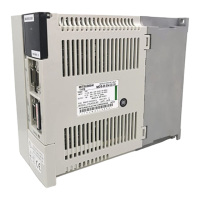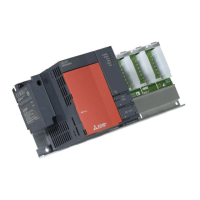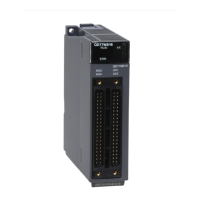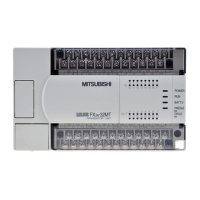Chapter 8 Troubleshooting
8-4
8-3 Protective functions list
8-3-1 Alarm
When an alarm occurs, the motor will stop by the deceleration control or dynamic brakes. At the same
time, the alarm No. will appear on the CNC monitor screen and with the LEDs on the front of the
amplifier. Check the alarm No., and remove the cause of the alarm by following this list.
No. Name Details Cause of occurrence Investigation method Remedy
Parameter confirmation (SV017. bit 0) Set correctly.
Check the output from the amplifier.
• Is connector (CN3) disconnected?
• Is the cable broken?
Connect correctly.
Replace the cable.
Check the contactor operation, check the
conductivity.
Replace the
contactor.
Contactor operation,
conductivity defect
Check the contactor drive relay operation,
and for conductivity defects.
Replace the relay.
Check the input voltage.
• Is a single-phase 200 V or 100 V input?
• Is there an open phase?
Input 3-phase 200 V.
10 Insufficient
voltage
The PN bus wire
voltage is 200 V or
less.
(Detected only
when the servo is
in a ready ON
status.)
Power supply wire
breakage of
undervoltage
Check the power capacity. Review the power
supply.
Check the repeatability. Replace the amplifier.13 Software
processing error
1
Software operation
sequence error or
operation timing
error
[Also detected
when the control
axis is removed.]
CPU peripheral circuit
error
Check the grounding state and ambient
temperature.
Improve the ambient
environment.
15 Memory error 2
Amplifier self-
diagnosis error.
(The amplifier LED
display reads
"-□".)
CPU peripheral circuit
error
Check the repeatability. Replace the amplifier.
Check the repeatability. Replace the amplifier.17 A/D converter
error
The A/D converter
conversion value
is incorrect.
CPU peripheral circuit
error
Check the grounding state and ambient
temperature.
Improve the ambient
environment.
The detector input
connector is
disconnected.
Check the connector (CN2) connection.
Check the cable connection.
Connect correctly.
The detector cable is
broken.
Replace with the cable for another axis and
check the repeatability.
Replace the detector
cable.
Detector fault
18 Motor side
detector: Initial
communication
error
Initial
communication
with the detector
was not possible.
[Also detected
when the control
axis is installed.]
Amplifier input circuit
fault
Exchange the detector and amplifier
connection with that for another axis and
check the repeatability. (Pinpoint the cause)
Replace the parts on
the side that caused
the alarm.
Check the repeatability. Replace the amplifier.22 LSI error LSI operation error
[Also detected
when the control
axis is removed.]
LSI operation error
Check the grounding state and ambient
temperature.
Improve the ambient
environment.
Motor power line (U, V,
W phase) ground fault
Replace the cable.
Correct the
connection.
24 Grounding A motor cable
ground fault was
detected.
(Detected only at
the ready ON
instant.)
Motor fault
Check the motor cable and connection.
Check the conductivity between cables.
Replace the motor.
Battery voltage drop Check the battery voltage with a test.
(Occurs at 3 V or less)
Replace the battery
The battery connector
(in the amplifier) is
disconnected.
Open the panel at the top of the amplifier
and check.
Connect correctly.
The battery line in the
detector cable is broken.
Check the conductivity with a tester. Replace the cable.
25 Absolute
position data lost
The absolute
position in the
detector was lost.
The detector cable was
disconnected when the
power was turned OFF.
After alarm 18 has occurred, correctly
connect the detector cable and turn the
power ON again.
Connect correctly.
2B Motor side
detector: CPU
error 1
Detector internal
circuit error
Detector fault Check the repeatability.
Check the ambient environment.
Replace the detector.
Review the ambient
environment.

